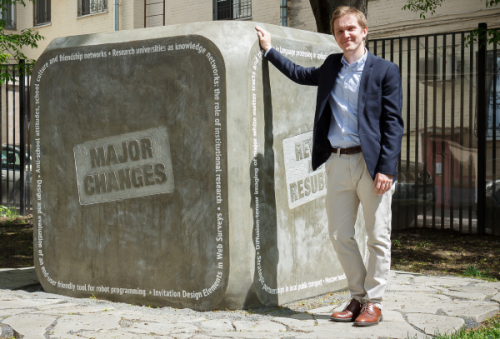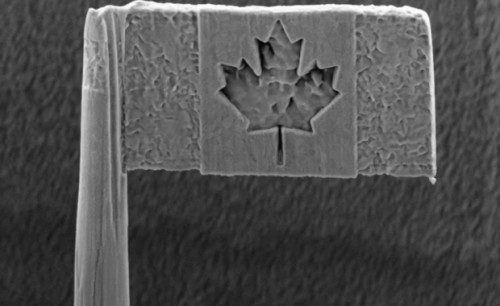
Cubist sculpture: a monument to peer review. (Courtesy: Igor Chirikov)
By Michael Banks and Hamish Johnston
You may remember a campaign to create a monument dedicated to those hard-working people who peer-review research papers. Last year, sociologist Igor Chirikov, from the National Research University Higher School of Economics in Moscow, raised $2521 on Kickstarter to turn an “ugly” block of concrete outside the university’s Institute of Education into a monument that reads “accept”, “minor changes”, “major changes”, “revise and resubmit” and “reject” on its five visible sides. Well, after months of toil that monument has now been unveiled by Chirikov in a ceremony at the institution that was attended by over 100 supporters. “Most understand the sarcastic nature of the monument and love it,” says Chirikov. “Many also wonder what’s on the bottom side of the monument.” Chirikov is thinking of hanging a small mirror on a nearby tree so that everyone can see “Accept” on the top of the cube.
Still on fundraising, the Marie Curie Alumni Association is launching an illustrated book series for young children called My Super Science Heroes. The first one – Marie Curie and the Power of Persistence – aims to introduce children to Curie and her key accomplishments in a “fun and engaging way”. To get the project off the ground, the association has taken to Indiegogo to raise €15,000. Each scientist in the series will have a certain “superpower”, which in the case of Curie is her persistence. “Unlike being bitten by a radioactive spider, scientific achievement is a realistic goal, and celebrating these real-life heroes will encourage kids to explore the many possibilities a [science, technology, engineering and mathematics] programme offers,” the association writes. There is a month still to go if you want to donate. If the project raises the cash then the book is expected to be released by mid-October.
While that book will most likely be printed in the usual way, how about getting your hands on the world’s first 3D-printed book? Well, soon you can thanks to a project kickstarted last year by the Israeli-born designer Ron Arad. The book – Genius: 100 Visions of the Future – will contain articles by 100 leading lights including Microsoft co-founder Paul Allen and the Nobel laureates Steven Chu and the late Harry Kroto. It is part of the Einstein Legacy project that celebrates 100 years since the publication of Albert Einstein’s theory of general relativity. The book is set to be unveiled at an event in Montreal, Canada on 9 September.

Big country: is this the smallest Canadian flag ever? (Courtesy: McMaster University)
Speaking of Canada, the country is celebrating its 150th anniversary this year. In honour of the sesquicentennial, Travis Casagrande at McMaster University in Hamilton, Ontario has made what just might be the smallest Canadian flag ever – measuring just one-hundredth the width of a human hair. He used a focused ion beam microscope to etch the 3D flag – complete with a flagpole – into a penny. You can read more about the tiny sculpture on the CBC website.
Guidelines
Show/hide formatting guidelines
this text was deletedwhere people live in harmony with nature and animals</q>
Some text